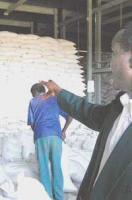







|
News and Information
Rotten rice for San
| February 23, 2006 |

* LINDSAY DENTLINGER
THE distribution of food aid by the Caprivi Emergency Management Unit has once again come under scrutiny, this time for delivering mouldy rice to San communities at Chetto, in the far western outskirts of the region.
At least five bags of the rice delivered to the community at the end of last month contained congealed rice and as yet unidentified black lumps.
Laboratory tests revealed that the rice had become damp and was contaminated with fungi and bacteria.
"It is definitely unfit for both human and animal consumption," clinical microbiologist Gisela Eberle from the State Veterinary Laboratory told The Namibian.
Testing for aflatoxins, a toxin produced by certain fungi in or on food, have not yet been completed.
The solid black lumps in the bags of rice could not yet been identified, Eberle said.
COMMUNICATION BREAKDOWN The lack of any form of communication in the area made it impossible for The Namibian to contact the village headman, but a volunteer working in the area, who did not want to be named, confirmed the delivery of the tainted food.
Around 800 people live at Chetto, most of whom do not have any means to feed themselves or access to basic services or communication.
Upon inquiry from The Namibian, the Emergency Management Unit Deputy Director Gabriel Kangowa was horrified to learn about the rotten rice delivery.
He said he planned to travel to the area at the end of the week and then on to Katima Mulilo, to get to the bottom of the situation.
But he said Remu officials at Katima Mulilo had informed him that the communities were instructed to feed the rotten rice to their chickens only and that it was not for human consumption.
Kangowa said it was normal for bags of rice or maize meal to tear during transportation and storage and that repacking did not necessarily render it unfit for human consumption.
But when a sample of the rotten consignment was shown to Kangowa, he said it was obvious that it could not be intended for human consumption.
The rotten rice appears to have been swept up from the floor and repacked in bags.
The rice was a donation from India at the height of the 2003/04 drought.
It could not immediately be determined how many bags of edible rice were delivered to the Chetto community at the same time as the rotten ones, but The Namibian understands that they were delivered along with dried fish, oil and beans.
Last year the Caprivi still received consignments of rice, but Kangowa told The Namibian that the last of it should have been delivered by the end of last year.
Caprivi Regional Governor Bernard Sibalatani and Chief Regional Officer Raymond Matiti have been put on leave and suspended respectively, pending disciplinary action for allowing 230 tonnes of maize meal to go to waste in a military warehouse at M'pacha last year.
When the investigation team first visited the warehouse in May, trucks of rice were being offloaded at the same warehouse.
Rice has a much longer shelf life than maize but, like maize, it has to be kept dry. |
Source: www.namibian.com.na |
| http://www.namibian.com.na/ |
|
| Support Caprivi Freedom |
Fill out the form below to become a member of this site and receive our regular newsletter.
|

|

